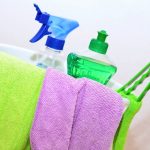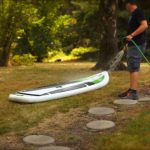Boating season is here! As you’re pulling your trailer with your boats out of the garage, the stains on the boats from all the days of fun on the water are impossibility to miss.
A boat can get very dirty even though it is always in water because the water doesn’t always clean it.
Not until you accidentally brush up against the boat while wearing a white T-shirt do you realize how bad it has gotten. It’s time to give it some love!
An inflatable boat should be cleaned with soap and water and treated with a UV protectant to ensure that it lasts as long as possible. There are two items you’ll need to purchase if you don’t already have them: NRS Inflatable Boat Cleaner and 303 Aerospace Protectant.
You will also need to get a lot of clean rags to wipe down the boat by hand.
You’ll need to be careful about when you clean your boat if you don’t have a garage to store it in. Weather conditions can damage your boat if you’re not cautious.
An overcast or cloudy day is the best time to clean your boat tubes, as the sun won’t cause the boat cleaner to evaporate before it has a chance to work on the stains and grime.
The dew has evaporated and the frost has melted off before you head out If it is later in the year and you are dealing with frosty mornings, you should wait until it is about 50 degrees outside so that the dew has evaporated and the frost has melted before you go outside.
a guide to cleaning & treating your inflatables
Step 1: Prewash
It’s much easier to clean your boat by spraying off any obvious mud and dirt before you start washing it by hand. If you are using a power washer at a carwash, it is best to keep the pressurized water at a distance to avoid damaging your seams or blasting dirt into them.
Clear out any leaves, sticks, and cam straps from the bail scuppers and spray them down. If you can’t go to a car wash, try looking at your boat. If you have a frame on your boat, you’ll be surprised at what you find.
Step 2: Elbow Grease
Now it’s time for the fun part – scrubbing the boat clean with Boat Cleaner. You’ll probably want to get some drinks and some good music because this part is tedious and takes a while.
Before you start cleaning your boat, it is recommended that you wear gloves to protect your hands, as recommended by NRS. I do not and my hands suffer for sure. This cleaner is very strong and biodegradable, but it is not good for your skin to expose your hands to it for a while.
After using my device for an hour, I noticed the skin on my fingers peeling. Do not use your bare hands when cleaning as it is risky. I also recommend using a spare spray bottle and mixing the cleaner with water in a 50-50 ratio. It functions just as efficiently at half strength and spares your hands somewhat.
If you apply cleaner to the entire surface of the boat at once, it will either evaporate or dry before you have a chance to wipe it off. Instead, you want to work section-by-section.
I use the seam boundaries to define each section. You should spray a cleaner on the areas you want to clean and let it sit for a minute. After that, scrub it off with a rag.
It’s amazing how well this stuff works. One wipe is usually all you need for most stains. For stubborn stains, reapply several times. This stuff can be used to clean river grime and metal wear from your frame and drybox.
Step 3: Rinse
Did you like having to wipe every square inch of the boat in the last step? Good! Now dampen a rag with water and wipe the area again. The goal is to get the boat cleaner and additional grime off before treating the boat in the last step.
After the boat cleaner has removed the majority of the dirt from the boat, you will be surprised at how dirty the rags become when you go over everything again. You will need some clean rags for this step, so that you don’t wipe the dirt back onto the boat.
There will be faint drip marks where the boat cleaner dripped around the tubes while you were working. Be sure to thoroughly clean the boat and check it closely to ensure you removed all the debris.
It’s important to spend some time on this step, as it will impact the effectiveness of the next step, which is applying 303. If the area you wipe with a damp rag no longer appears soapy, you are finished. Then, let the boat fully dry.
Step 4: 303 Aerospace Protectant
Now that your boat is clean, you need to apply 303. You should never apply 303 to your boat without first cleaning it. The cleaner the boat is, the better the 303 will work. It is important to maintain the material your boat is made out of and to protect it from the sun.
Over time, exposure to the sun’s radiation will cause vinyl and rubber materials to deteriorate. It is better to store your boat in the shade or in a garage/storage unit.
Make sure you know the materials your boat is made of before using 303. These are PVC and Hypalon. There are two primary materials used in the construction of inflatable boats: PVC and Hypalon. There are two types of plastic that are most widely available.
The first is Polyvinyl-chloride, or PVC. It makes up the bulk of the exterior of the boat The second most common type of rubber used in boat construction is synthetic rubber, which is also known by the trade names Hypalon or Pennel-Orca.
This type of rubber makes up the majority of the exterior of the boat. While 303 Aerospace protectant can help keep your PVC boat in good condition, it can also cause problems if used incorrectly. PVC is a flexible material, but the plasticizers that make it flexible can be damaged by 303 if it is over-applied or applied too frequently.
PVC boats generally don’t last as long as Hypalon boats because Hypalon is a stronger material. In contrast, Hypalon can be exposed to 303 without causing any damage.
HOW TO MAINTAIN YOUR BOAT
- Fiberglass and gelcoat, which needs to be regularly cleaned, waxed, and polished for both protective and cosmetic purposes. Not only will keeping your gel coat shiny make your boat look good, but it will also prevent oxidation, which makes fiberglass dull and chalky.
- Marine canvas and Eisinglass or Strataglass, which deteriorate quickly without proper treatment. You’ll need to regularly use the correct polishes and protectants, or canvas will grow leaky and clear canvas will become cloudy.
- Upholstery and vinyls found on boats. These need to be cleaned several times a season—but if you use the wrong type of cleaner, you can accidentally destroy the materials in a single season.
- Brightwork, which includes all wood surfaces and trims that are exposed to UV rays. They require quite a bit of upkeep, to keep them in good shape. We’ll show you how to refinish dull-looking wood, and describe the seasonal maintenance you’ll need to do every spring.
GELCOAT, WAXES, AND POLISHES
If you own a fiberglass boat, you are likely to have to maintain the gelcoat on the deck and sides of the hull. Gelcoat is the tough, glossy exterior finish that protects the underlying fiberglass from salt, sun, and everything else Mother Nature can throw at it.
In poor condition, it’s usually a hazy, chalky mess. The good news? To bring a faded gelcoat back to its original color, you will need to use the right compounds and scrub it with a lot of force. If your gelcoat is in good condition, you can maintain it throughout the season. Essential gelcoat maintenance begins with waxing and/or polishing.
What’s the difference between wax and polish? Waxes act as a barrier between gelcoat and the environmental elements that can damage it. Polishes generally contain a cutting agent to remove oxidation from the gelcoat and make it shine. There are other products available that are called cleaner-waxes.
These products contain both a polish and a wax. The following products work well on gelcoat that is lightly or moderately oxidized. The large number of different waxes and polishes that are available to buy from a marine supply store can be difficult to choose from.
You might find that all you need to bring back the lustrous look to your boat is a little elbow grease Before you start cleaning your boat, try reading Boat Waxes and Polishes for Making Your Gelcoat Shine.
You might find that all you need to bring back the lustrous look to your boat is a little elbow grease. You will find a selection of products that we have personally tested.
MARINE CANVAS AND EISENGLASS OR STRATAGLASS
“Canvas” is the term used for the durable fabrics used to create various objects on boats, such as cockpit and console enclosures, Bimini tops, boat and sail covers, line and gear pockets, etc.
Some materials may be described by the trade name “Sunbrella.” “Eisenglass” and “Strataglass” are two different brands of clear PVC that is used to make the see-through panels in marine canvas components.
No matter what kind of materials your boat is made of, it is important to take care of it so that it will last longer and look good.
Keeping your canvas clean is key, however, avoid washing or drying it in a household washer or dryer as this will ruin the fabric quickly. Use a soft brush, detergent, and plenty of fresh water to remove dirt, salt, bird excrement, and other harsh materials.
This ensures that the fabric’s UV and waterproofing components remain effective and also prevents mould from developing in the fabric. If your marine canvas is no longer as waterproof as it used to be, you can treat it with a product like 303 Fabric Guard to restore its water-repelling ability.
A helpful tip is to not try and stretch your canvas when the temperature is below 65 degrees, as the material is more likely to tear. The clear PVC windows on marine canvas can be troublesome to take care of.
The components of a boat being ruined by the use of wrong products is a problem many boat owners face. Whether you’ve got Eisenglass, Strataglass, or some other PVC material in your canvas, you should never—and we mean never—clean them with an ammonia-based product such as Windex.
If you put ammonia on plastic, it will start to break it down, make it yellow, and make it more brittle. A quality spray polish designed specifically for clear PVC should be used instead of a general purpose cleaner. 210 Plastic Cleaner and Polish is a good option. PVC panels can last for years if they are taken care of properly.
UPHOLSTERY AND VINYL
In the past, most boats had only a few cushions on board, located in strategic places around the deck where people could relax. Small boats today often come with a large number of comfortable seats, upholstered with a variety of high-tech fabrics and materials.
How should you take care of these expensive, handcrafted items that bring you comfort? The most popular material used for exterior seating and furniture components is vinyl, which has been created decades ago. It is a tough and extremely durable material, but if you use the wrong cleaners it can ruin it.
To clean on a routine basis, you can use a sponge and a bucket of mild, soapy water. Thoroughly rinse afterwards. Never use strong cleaners that contain bleach or ammonia.
These chemicals will break down and ruin the vinyl over time, although they can produce immediate and pleasing results, especially on vinyl with mildew stains.
To deep clean your vinyl, start by using a purpose-made vinyl cleaner. Once you’ve applied the cleaner, follow up with a vinyl protectant. You should regularly clean and protect your vinyl records, especially those that are kept in areas where they are exposed to the elements.
Mildew stains are something you will likely have to deal with on your vinyl at some point, no matter how well you take care of it. If you spot any mildew staining, you could try lightly scrubbing it with a diluted solution of Oxy Clean in hot water.
This shouldn’t cause staining on other fabrics on the boat. There are mildew cleaners available at a marine supply store, but we have not had much success with them. If your vinyl is severely stained, you can try using bleach diluted in water or cleaners that contain bleach.
Make sure you don’t get any solution on any of the canvas or other fabrics on your boat. Remove the pieces from the boat and clean them at home if possible.




